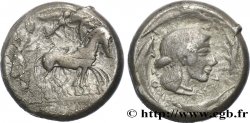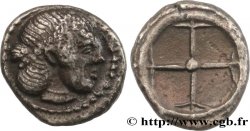v18_0032 - SICILIA - SIRACUSA Tétradrachme
MONNAIES 18 (2003)
起拍价 : 2 500.00 €
估价 : 3 800.00 €
竞价记录 : 5 293.00 €
出价数量 : 10
最高出价 : 5 600.00 €
起拍价 : 2 500.00 €
估价 : 3 800.00 €
竞价记录 : 5 293.00 €
出价数量 : 10
最高出价 : 5 600.00 €
种类 Tétradrachme
日期: c. 475-470 AC.
铸币厂名称/城市 Syracusa
材质 silver
直径 26 mm
模子方针 3 h.
重量 17,43 g.
稀少度 R2
发行人: groupe 3, série 12a
关于品相的说明
Flan large et complet des deux côtés. Exemplaire de qualité exceptionnelle avec une extraordinaire patine de médaillier à reflets bleutés et mordorés. Portrait magnifique avec une expression vivante. Au droit, le bige semble se mouvoir dans le champ
出版目录中的项代码 :
家谱
Cet exemplaire provient de la collection Weber, L. Forrer, The Weber collection of Greek coins, Londres 1922, n° 1564
正面
正面的文字 ANÉPIGRAPHE.
正面的说明书 Bige au pas à droite, conduit par un aurige tenant les rênes et le kentron ; le bige est couronné par Niké volant à droite.
背面
背面的文字 N RÉTROGRADE.
背面的说明书 Tête d'Aréthuse à droite, les cheveux relevés et retenus par un diadème de perles, entourée de quatre dauphins.
背面铭文 SUR-AK-OSI-ON
评论
Poids lourd. Le style est caractéristique et l’exemplaire très bien gravé avec beaucoup de finesse. Mêmes coins que l’exemplaire du trésor de Randazzo (n° 462) et que celui de la collection de l’American Numismatic Society (n° 97).








 对产品描述纠错
对产品描述纠错 打印
打印 分享我的选择
分享我的选择 提问
提问 Consign / sell
Consign / sell
 产品介绍
产品介绍









